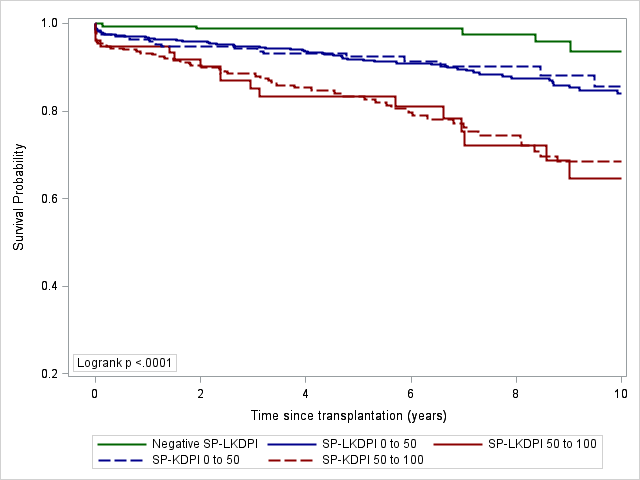Improving Allograft Survival by Informing Donor Selection in Kidney Transplant Recipients Under 5 Years Old
Emory University, Atlanta, GA
Meeting: 2021 American Transplant Congress
Abstract number: 1014
Keywords: Donation, Graft survival, Kidney, Pediatric
Topic: Clinical Science » Kidney » Kidney: Pediatrics
Session Information
Session Name: Kidney: Pediatrics
Session Type: Poster Abstract
Session Date & Time: None. Available on demand.
Location: Virtual
*Purpose: The kidney allocation system aims at allocating high-quality kidneys in pediatric recipients but the KDPI score used to assess the quality of the donors may not accurately predict graft survival of pediatric recipients. We aimed at assessing KDPI accuracy to predict graft failure in pediatric recipients and at developing predictive models of graft loss for deceased and living donor transplants to inform donor selection.
*Methods: We included all first-time, kidney only transplant recipients under 18 years old from the SRTR database receiving a transplant from an adult donor between January 2005 and August 2018. The primary outcome was graft failure, defined as dialysis, re-transplantation, or death with a functioning graft. Kaplan-Meier and Cox methods were used to assess KDPI accuracy in the overall cohort. To improve donor selection in children < 5 years old at kidney transplantation, we developed a Small Pediatric-KDPI (SP-KDPI) and Small Pediatric-Living KDPI (SP-LDKPI) on the same scale to compare each other by using Cox models adjusted for recipients characteristics.
*Results: KDPI C-statistic was 0.52 (95% CI = 0.50 – 0.54) in all pediatric recipients of adult deceased donors kidneys and higher KDPI was not associated with higher rate of graft failure in recipients < 5 years old. Six deceased donor factors were included in the SP-KDPI computation (ethnicity, age, body surface area, gender, cold ischemia time, HLA-B mismatches number). Four living donor factors were included in the SP-LKDPI computation: race, age, HLA-B mismatch number and donor/recipient body surface area ratio. Model accuracies were validated internally by cross-validations and C-statistics were 0.64 (95% CI = 0.57 - 0.70) and 0.65 (95% CI = 0.58 - 0.73) for SP-KDPI and SP-LKDPI, respectively. Figure 1 presents allograft survival stratified by donor type and SP-(L)KDPI stratum. SP-LKDPI identified 16.8% of living donors with predicted graft survival superior to any deceased donor.
*Conclusions: The current KDPI allocates good kidneys (< 35%) to pediatric recipients but provides little information to guide donor selection especially in recipients younger than 5 years old. We developed an adaptation of the KDPI that demonstrated a higher accuracy to predict graft loss in young recipients. We also developed an extension of this score to accurately compare adult living and deceased donors offered to young recipients.
To cite this abstract in AMA style:
Barayre FManca, Greenbaum L, Garro R, Winterberg P, Patzer R, Hogan J. Improving Allograft Survival by Informing Donor Selection in Kidney Transplant Recipients Under 5 Years Old [abstract]. Am J Transplant. 2021; 21 (suppl 3). https://atcmeetingabstracts.com/abstract/improving-allograft-survival-by-informing-donor-selection-in-kidney-transplant-recipients-under-5-years-old/. Accessed December 14, 2025.« Back to 2021 American Transplant Congress

